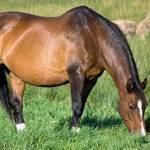Putting Broodmares Under Lights

In one way, keeping broodmares under lights is easy: just leave the barn lights turned on in the evening. Getting the result you want, however—mares that begin to cycle earlier in the spring—may take a little more thought. What level of extra light do the mares need? How many weeks or months do the lights need to stay on? And are there any drawbacks to this management practice?
Under natural conditions, mares begin their heat cycles in mid to late spring, responding more to the lengthening daylight hours rather than warmer climatic conditions. To trick the mares into cycling earlier in the spring, broodmare managers have devised a system of leaving barn lights on in the evening after the sun has set in order to mimic about 16 hours of daylight. If this practice is started in early December, most mares will start to cycle by early March.
A general rule of thumb is to provide enough extra light so that a person can easily read a newspaper anywhere in the horse’s stall. It’s important that the horse actually sees the light, so a mare that likes to stand with her head stuck out the stall’s window won’t benefit unless the window is closed in the evening. Likewise, a mare that hangs her head over the stall door into a dark barn aisle all evening won’t be helped, though her stall may be brightly lit. In this case, light the aisle or close the top of the stall door to be sure the mare is exposed to plenty of light.
Owners who have not had success in using lights to get early breeding cycles in mares may have begun the lighting too late in the year, missed a few nights of turning the lights on, used lights that were not bright enough, or ended the program too early in the spring. Even after the mares begin to come into heat, supplemental lighting needs to be continued until the hours of natural daylight total 14 to 16 hours. As sunrise moves earlier through the spring, evening lighting can be tapered off.
Under normal circumstances, there are no drawbacks to keeping mares under lights. In fact, putting early-foaling mares under lights will help them cycle quickly after delivering their foals. However, exposure to extra light can influence the mare to deliver her foal as much as a week earlier than normal. For breeds such as Thoroughbreds that consider January 1 as the birthday for all foals born in a particular year, delivering late in December rather than early in January can be a serious problem. Caution should be used when considering supplemental light for mares whose foals are expected very early in January.








